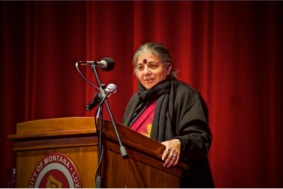Graduate students in the Environmental Science and Natural Resource Journalism program used several social media platforms for reporting live coverage of Vandana Shiva’s lectures at the University of Montana last week.
By reporting live, via Twitter, Instagram and Periscope, the grad students tried to engage with a broader audience and instigate a conversation with people who weren’t physically present to hear Shiva speak. Prior to Shiva’s talks, to gain journalistic insight on Shiva’s influence, Associate Professor Nadia White had the grad students read a controversial profile on Shiva that the New Yorker published in August 2014 and the consequent responses from Shiva, the New Yorker’s editor and outside journalists.

Vandana Shiva, an environmental activist who passionately opposes genetically modified organisms (GMOs), spoke at the University of Montana on Wednesday, February 24th. During the afternoon she led a seminar called “Living Seed, Living Soil, and Earth Democracy”. Then, in the evening Shiva spoke as part of the Brennan Guth Memorial Lecture series, sponsored by both the Environmental Philosophy and Environmental Studies programs. Both presentations were part of the on-going President’s Lecture Series at UM.
Shiva’s evening lecture, “We Are All Seeds: Food Security and Environmental Sustainability,” followed the metaphor of humans as seeds, as Shiva spoke about the need to preserve the diversity and health of both physical and metaphorical seeds. Her presentation was met with a packed theater and three standing ovations. More people queued up for the Question & Answer sections than she had time to address.
From Shiva’s hotel room in Missoula, she said that looking out at the Clark Fork River reminded her of where she grew up in India. Over the years, she watched a swimming stream dry into a trickle and a natural forest turn into cultivated apple orchards. “I realized how vitally our ecosystems are under threat,” Shiva said. “And how much we took them for granted.”
Some J-school graduate students took Shiva’s quotes to Twitter—capturing both the questions Shiva raised as well as her prolific statements about how industrialization has changed humans’ relationship with nature. Katy Spence received an immediate like when she captured Shiva’s message, “We’ve been brainwashed to believe we are separated from nature…that nature is dead.”
Courtney Gerard also felt quick support from Instagram after posting pictures of Shiva speaking in the Dennison Theater. Gerard also had an eye on the crowd and captured a few people thinking more critically of Shiva’s message. While she snapped pictures of the audience and Shiva from center stage, Gerard left her tape recorder running so she could accurately quote the lecture in further stories.
Benjamin Alva Polley noted Shiva’s efforts to make a connection with UM community members. Polley tweeted Shiva’s opinion, “Campuses are not just about education anymore, but about life.” At the evening lecture, a researcher at UM asked Shiva what she would tell academics researching GMOs and furthermore, what evidence would she need to change her absolutist stance against GMOs.
“My scientific background tells me this is not the future,” Shiva said. She continued to speak about the corporations promoting GMOs “only to collect royalties,” and called GMO research an “inaccurate science” and “failed technology.”
Looking out at the full auditorium, Shiva asked, “How long do these corporate benefactors take care of you or the planet?”
Graduate student Matt Roberts noticed the lack of verifiable, scientific facts backing up Shiva’s prolific speech. He produced a multimedia article via Storify that addressed the disconnect between Shiva’s anti-GMO beliefs and the vague scientific facts she cited. In Roberts’ editorial “Going Through The GMOtions” he wrote, “If you attended the event to gain a deeper level of understanding about how GMO’s work and why they might be bad other than “because it’s unnatural and people say so,” then you were probably left a little confused.”
During one example, Shiva cited the rates of autism prevalence in the United States as 1 in 35 people and faulted BT toxins and GMOs in gut bacteria. She predicted that ratio would rise to 1 in 2 in the next hundred years.
However, current autism research reflects a ratio of 1 in 68, and to understand autism’s role in the brain, current research focuses more on the neurological and genetic causes. Additionally, autism experts think that the recent rise in both awareness and diagnoses programs also contribute to the rising rates of people who experience autism spectrum disorder (ASD), so Shiva’s prediction reflects more on scare-tactics than scientific fact.
Coming from a journalist perspective, the main challenge came not from any controversial opinions about GMOs or Shiva’s personal beliefs, but from the lack of her ability to answer the basic and specific “who, what, where, when, why and how” questions.
While Robert acknowledged Shiva as a notable scholar, the tone of her lecture made him feel like he was reporting on a politician instead of a scientist. Roberts said, “The whole evening was an anti-GMO pep rally.”
The next event in the Presidential Lecture Series, will take place on Monday, March 21st and feature Roald Hoffmann, who won the Nobel Prize in Chemistry in 1981.
By Jana Wiegand
